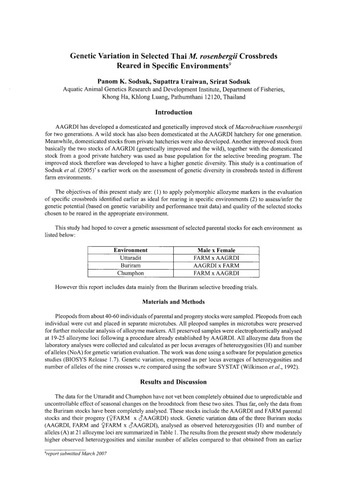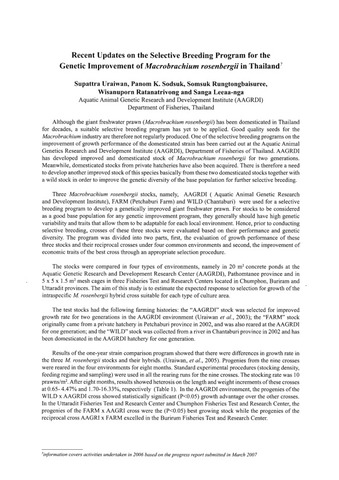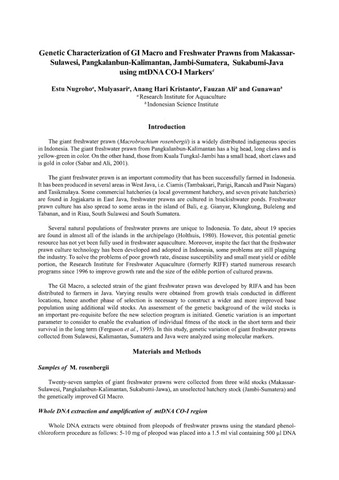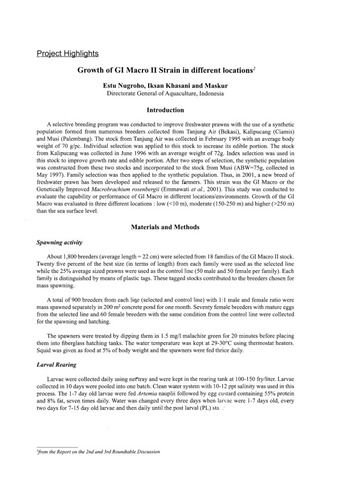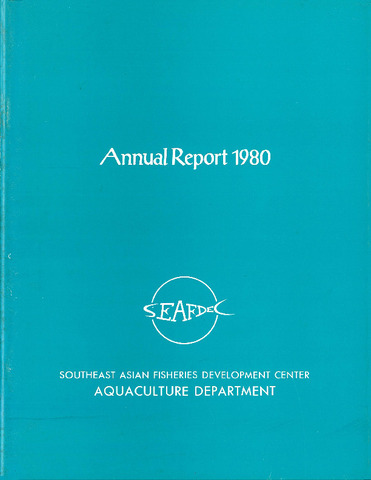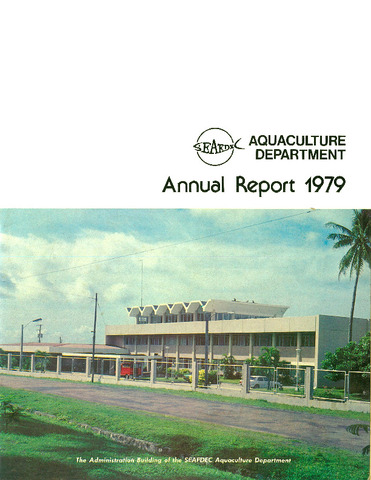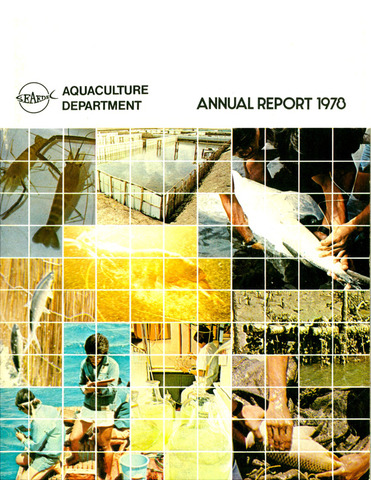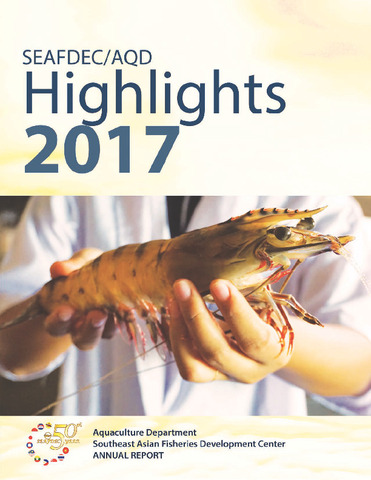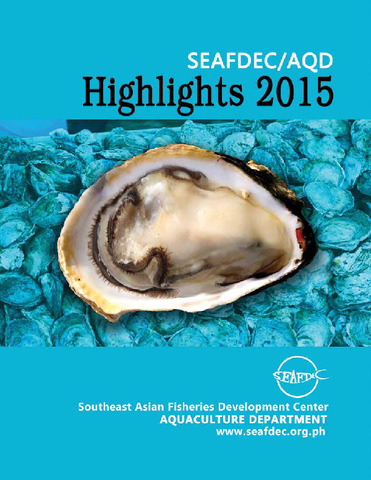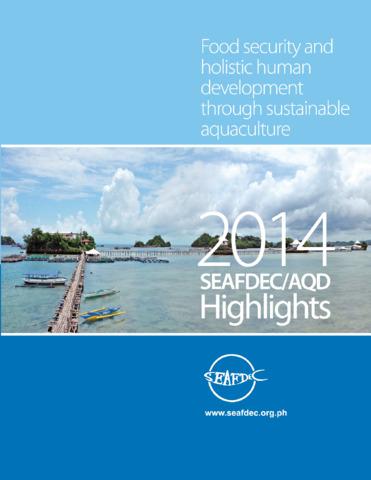Institutional and Meeting Reports: Recent submissions
Now showing items 41-60 of 290
-
Genetic variation in selected Thai M. rosenbergii crossbreds reared in specific environments
(Aquaculture Department, Southeast Asian Fisheries Development Center, 2007)AAGRDI has developed a domesticated and genetically improved stock of Macrobrachium rosenbergii for two generations. A wild stock has also been domesticated at the AAGRDI hatchery for one generation. Meanwhile, domesticated ... -
Allozyme-based genetic variation in crossbreds produced from three Thai Macrobrachium rosenbergii stocks
(Aquaculture Department, Southeast Asian Fisheries Development Center, 2007)Molecular technology at enzyme/protein level known as “allozyme marker” is a widely accepted powerful technique to study genetic variation (Ward and Grewe, 1995) as well as intraspecific population studies (Sodsuk, 1996; ... -
Recent updates on the selective breeding program for the genetic improvement of Macrobrachium rosenbergii in Thailand
(Aquaculture Department, Southeast Asian Fisheries Development Center, 2007)Although the giant freshwater prawn (Macrobrachium rosenbergii) has been domesticated in Thailand for decades, a suitable selective breeding program has yet to be applied. Good quality seeds for the Macrobrachium industry ... -
Preliminary growth comparison of three Macrobrachium rosenbergii stocks and their reciprocal crosses in four environments
(Aquaculture Department, Southeast Asian Fisheries Development Center, 2007)Three stocks of Macrobrachium rosenbergii namely, “AAGRDI” (Aquatic Animal Genetic Research and Development Institute), “FARM” (Petchaburi Farm) and “WILD” stocks were used for the selective breeding program. Generally, a ... -
Macrobrachium culture industry in Thailand
(Aquaculture Department, Southeast Asian Fisheries Development Center, 2007)There are numerous freshwater prawns classified under the genus Macrobrachium which is generally categorized under the Family Palaemonidae Rafinesque, 1815, sub-family Palaemoninae Rafinesque, 1815. In Thailand, 19 ... -
Genetic characterization of GI Macro and freshwater prawns from Makassar-Sulawesi, Pangkalanbun-Kalimantan, Jambi-Sumatera, Sukabumi-Java using mtDNA CO-I markers
(Aquaculture Department, Southeast Asian Fisheries Development Center, 2007)The giant freshwater prawn (Macrobrachium rosenbergii) is a widely distributed indigenous species in Indonesia. The giant freshwater prawn from Pangkalanbun-Kalimantan has a big head, long claws and is yellow-green in ... -
Collection and evaluation of wild and farmed stocks of giant freshwater prawn in Indonesia
(Aquaculture Department, Southeast Asian Fisheries Development Center, 2007)Giant freshwater prawn is an important commodity that has been cultured successfully in Indonesia. Freshwater prawn farming has been adopted in several areas of West Java, i.e. Ciamis (Tambaksari, Parigi, Rancah and Pasir ... -
Growth of GI Macro II strain in different locations
(Aquaculture Department, Southeast Asian Fisheries Development Center, 2007)A selective breeding program was conducted to improve freshwater prawns with the use of a synthetic population formed from numerous breeders collected from Tanjung Air (Bekasi), Kalipucang (Ciamis) and Musi (Palembang). ... -
Giant freshwater prawn culture in Indonesia
(Aquaculture Department, Southeast Asian Fisheries Development Center, 2007)Indonesia is one of the countries in Asia with rich biodiversity, particularly in terms of the number of endemic freshwater aquatic organisms. Numerous indigenous freshwater fish species are found in Sumatera (30 spp.), ... -
Annual report 1980
(Aquaculture Department, Southeast Asian Fisheries Development Center, 1981)An overview of the 1980 activities of the center is presented. The aquaculture research presently underway at each research station is briefly reviewed. -
Annual report 1979
(Aquaculture Department, Southeast Asian Fisheries Development Center, 1980)The annual report for 1979 is presented. A summary of the centre's activities is given with particular emphasis on the milkfish, Chanos chanos, programme and the prawn programme. Administrative details are included. -
Annual report 1978
(Aquaculture Department, Southeast Asian Fisheries Development Center, 1979) -
SEAFDEC/AQD highlights 2018
(Aquaculture Department, Southeast Asian Fisheries Development Center, 2019)SEAFDEC/AQD highlights 2018 is SEAFDEC/AQD's annual report updating on its accomplishments and progress for the year 2018. -
SEAFDEC/AQD highlights 2017
(Aquaculture Department, Southeast Asian Fisheries Development Center, 2018)SEAFDEC/AQD highlights 2017 is SEAFDEC/AQD’s annual report updating on its accomplishments and progress for the year 2017. -
SEAFDEC/AQD highlights 2016
(Aquaculture Department, Southeast Asian Fisheries Development Center, 2017)SEAFDEC/AQD highlights 2016 is SEAFDEC/AQD’s annual report updating on its accomplishments and progress for the year 2016. -
SEAFDEC/AQD highlights 2015
(Aquaculture Department, Southeast Asian Fisheries Development Center, 2016)The SEAFDEC Aquaculture Department is mandated to: 1) conduct scientific research to generate aquaculture technologies appropriate for Southeast Asia; 2) develop managerial, technical and skilled manpower for the aquaculture ... -
2014 SEAFDEC/AQD highlights
(Aquaculture Department, Southeast Asian Fisheries Development Center, 2015)The SEAFDEC Aquaculture Department is mandated to: 1) conduct scientific research to generate aquaculture technologies appropriate for Southeast Asia; 2) develop managerial, technical and skilled manpower for the aquaculture ... -
2013 SEAFDEC/AQD highlights
(Aquaculture Department, Southeast Asian Fisheries Development Center, 2014)The SEAFDEC Aquaculture Department is mandated to: 1) conduct scientific research to generate aquaculture technologies appropriate for Southeast Asia; 2) develop managerial, technical and skilled manpower for the aquaculture ... -
Preliminary studies on predicting the setting season of oysters for the benefit of shellfish farmers
(Aquaculture Department, Southeast Asian Fisheries Development Center, 1981)Preliminary findings from a spatfall forecasting programme initiated in April 1981 at Himamaylan River, Negros Occidental are presented. Two main activities are involved: 1) monitoring of daily counts of oyster larvae in ... -
Acute toxicity of un ionized ammonia to milkfish (Chanos chanos) fingerlings
(Aquaculture Department, Southeast Asian Fisheries Development Center, 1981)The acute toxicity of un-ionized ammonia to milkfish (Chanos chanos) fingerlings was determined using a static bioassay system. Median lethal concentrations found show that milkfish fingerlings have a high tolerance to ...

